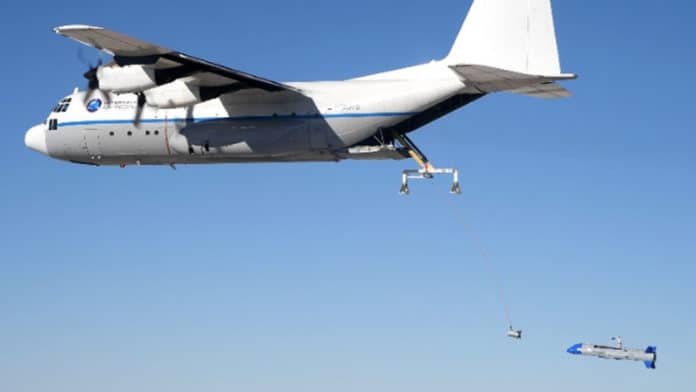The American DAPRA – Defense Advanced Research Projects Agency, has developed a Gremlins program that aims to attempt airborne retrieval of unmanned air vehicles. The agency reported that it ended the 2020 test campaign, managing to recover its three X-61A Gremlins Aerial Vehicle (GAV) in flight. However, the three X-61A Gremlins missed success by “just inches” during recent tests over Dugway Proving Ground, Utah.
In DARPA’s latest flight test series, each X-61A Gremlins Air Vehicle (GAV) flew for more than two hours, successfully validating all autonomous formation flying positions and safety features. In the end, nine flight recovery attempts were made at the mechanical engagement of the GAVs to the docking bullet extended from a C-130 aircraft. But the relative movement was more dynamic than expected, and each GAV ultimately safely parachuted to the ground.
“All of our systems looked good during the ground tests, but the flight test is where you truly find how things work,” said Scott Wierzbanowski, program manager for Gremlins in DARPA’s Tactical Technology Office. “We came within inches of connection on each attempt, but, ultimately, it just wasn’t close enough to engage the recovery system.”
The agency reports that it analyzes the data received from the flights and works for updated models and designs. It intends to conduct additional flights and retrieval attempts in a fourth deployment this spring. Wierzbanowski is convinced that the C-130 will be able to clear the airborne retrieval next time.
“We made great strides in learning and responding to technological challenges between each of the three test flight deployments to date,” said Wierzbanowski. “We were so close this time that I am confident that multiple airborne recoveries will be made in the next deployment. However, as with all flight testing, there are always real-world uncertainties and challenges that have to be overcome.“
The Gremlins program’s goal is to demonstrate air launch and air recovery of four GAVs within 30 minutes. DARPA, which has been working on the program for several years, believes that the possibility of conducting “safe, effective, and efficient air recoveries will dramatically expand the potential uses of unmanned air vehicles in conflict situations.”
The GAVs can be equipped with a variety of sensors and other mission-specific technologies. They can also be launched from various types of military aircraft, keeping those less expendable assets beyond the range of adversary defenses. After air retrieval of GAVs, they would be transported back to the ground, where crews could prepare them for another mission within 24 hours. The gremlins’ expected lifetime of about 20 uses could provide significant cost advantages over expendable systems by reducing payload and airframe costs and by having lower mission and maintenance costs than conventional platforms.
